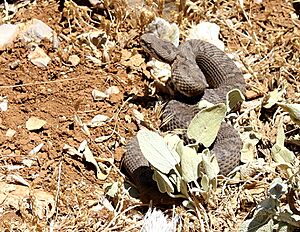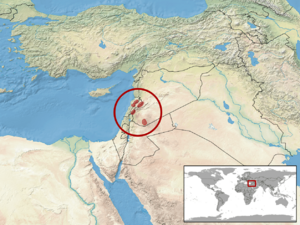Lebanon viper facts for kids
Quick facts for kids Lebanon viper |
|
|---|---|
 |
|
| Conservation status | |
| Scientific classification | |
| Genus: |
Montivipera
|
| Species: |
bornmuelleri
|
 |
|
| Synonyms | |
|
|
The Lebanon viper (Montivipera bornmuelleri) is a type of venomous snake. It is also known as Bornmueller's viper. This snake belongs to the Viperidae family, which includes many well-known vipers. It lives in Western Asia. There are no different types or subspecies of this snake.
Contents
About the Name
The second part of the snake's scientific name, bornmuelleri, is a special tribute. It honors a German botanist named Joseph Friedrich Nicolaus Bornmüller.
What It Looks Like
The Lebanon viper can grow up to about 75 centimeters (30 inches) long, including its tail. However, most of them are much smaller. In some areas, male vipers tend to be larger than females. For example, in Mount Lebanon, females were measured up to 47.3 centimeters (18.6 inches). Males from the same area were a bit longer, reaching up to 53.8 centimeters (21.2 inches). The tail makes up a small part of its total length, usually about 7 to 10 percent.
Where It Lives and Its Home
You can find the Lebanon viper in high mountain areas. These areas are in Israel, Lebanon, and Syria. It likes to live in certain types of places. These include cedar forests, areas with lots of shrubs, and high mountain grasslands.
Reproduction
The Lebanon viper is a viviparous snake. This means that instead of laying eggs, the mother gives birth to live young. The baby snakes develop inside her body until they are ready to be born.
How Scientists Classify It
Scientists study animals to understand how they are related and to give them proper names. The Lebanon viper was first described by a scientist named Franz Werner in 1898. He found specimens in Lebanon and Turkey. Over time, scientists like Robert Mertens and others refined its classification. They confirmed that the vipers found in Lebanon were a distinct species. This helps us understand the diversity of snakes in the world.
Conservation Status
The Lebanon viper is currently classified as an Endangered (EN) species. This means it faces a high risk of disappearing from the wild. This classification was made by the IUCN Red List of Threatened Species in 2006.
There are a few reasons why it's endangered:
- It lives in a very small area, less than 5,000 square kilometers (1,931 square miles).
- Its populations are spread out and found in only a few locations (no more than 5).
- The places where it lives, its habitat, are shrinking or getting worse. This means there are fewer safe places for these vipers to live and thrive.


